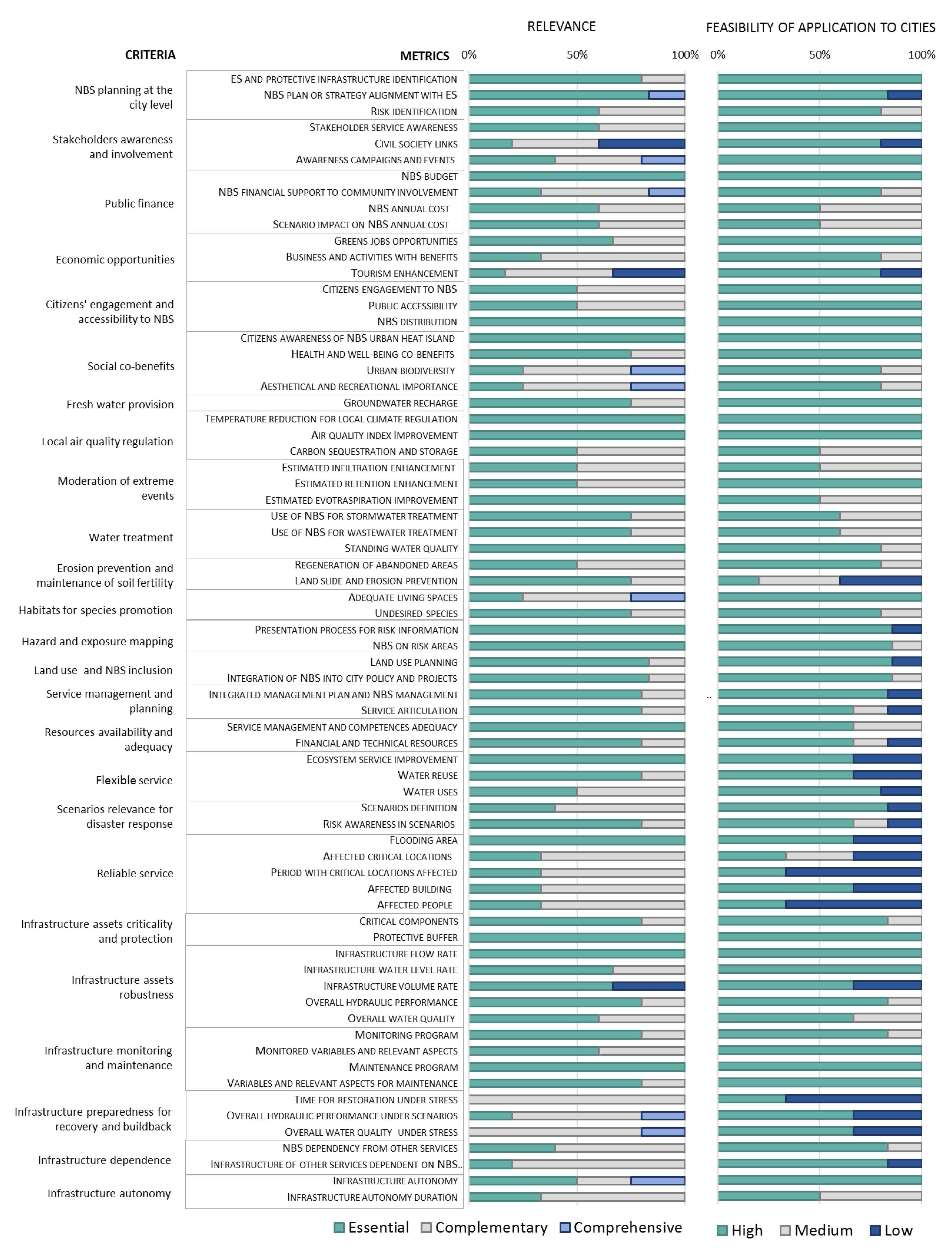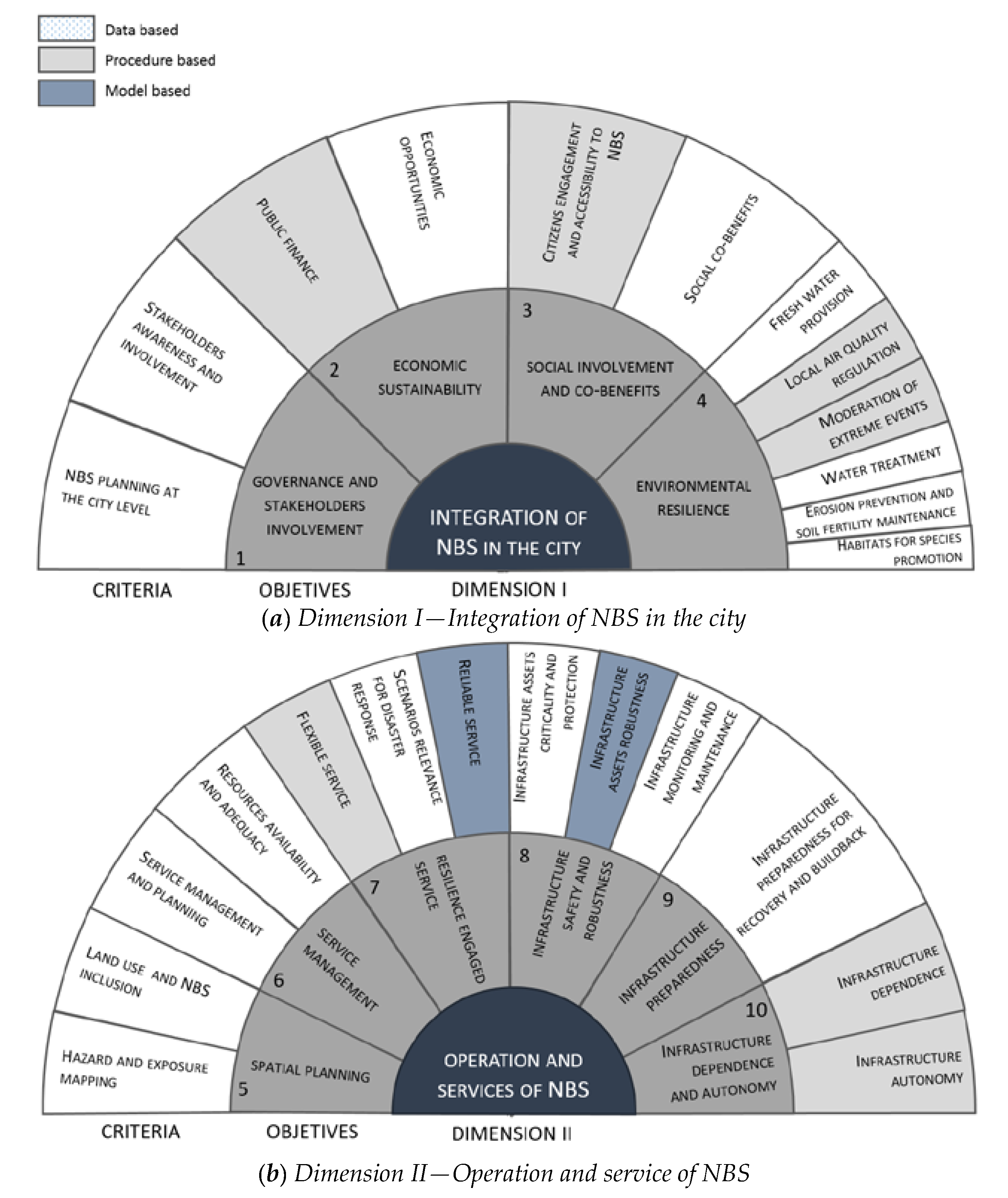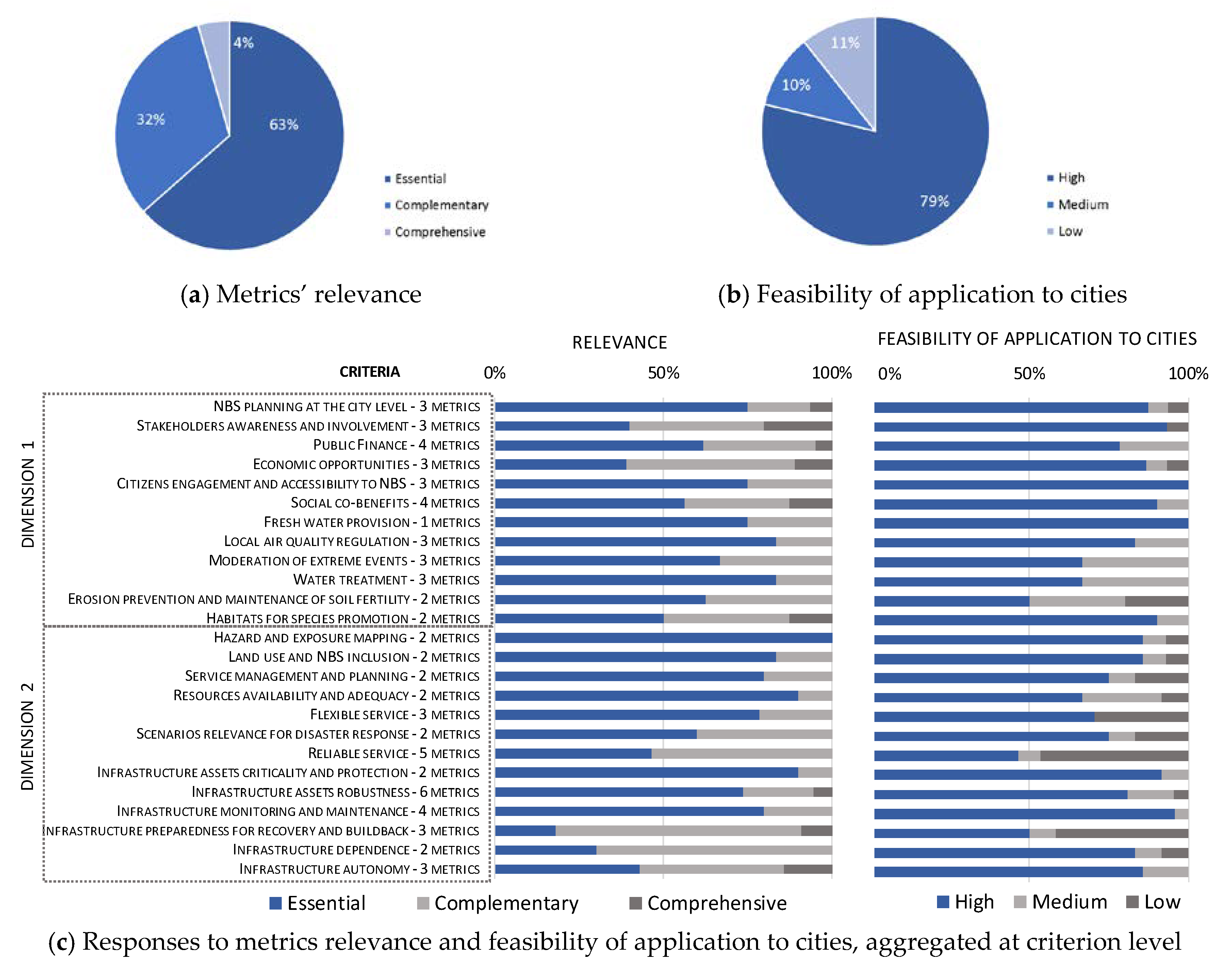The Contribution of NBS to Urban Resilience in Stormwater Management and Control: A Framework with Stakeholder Validation
Abstract
1. Introduction
2. Methodology
2.1. Construction of a Resilience Assessment Framework for NBS
2.2. Step 1: Identification of the Urban Resilience Dimensions in the RAF
2.3. Step 2: Definition of Objectives, Criteria and Metrics
2.4. Step 3: Validation of the Objectives, Criteria, and Metrics of the RAF
2.5. Step 4: Definition of Reference Values for Each Metric
2.6. Complementary Profile
3. Resilience Assessment Framework for NBS
3.1. Overall RAF Structure
3.2. Urban Resilience Dimensions (Step 1)
3.3. Objectives, Criteria, and Metrics (Step 2)
- Objective 1—Governance and stakeholders’ involvement aims to ensure NBS planning at city level and the stakeholders’ awareness and involvement. The criteria associated with this objective are the NBS planning at the city level and the stakeholder awareness and involvement. The criteria assess the governance component at city level, evaluating the adequacy of the NBS planning, the identification of the risk, identification of ES and protective infrastructure and the NBS alignment with ES. The proposed criteria also assess the stakeholders’ engagement, the community involvement in the NBS processes (e.g., planning, decision making) and the existence of awareness campaigns.
- Objective 2—Economic sustainability aims to ensure financial capacity related to NBS and potential economic opportunities. The proposed criteria for this objective are the public finance and the economic opportunities. The criteria assess the existence of a specific budget for NBS, identify the monitoring and maintenance annual costs and assess the development of initiatives to promote the NBS in households. Concerning the economic opportunities, the criteria identify the creation of new green jobs, business and activities and tourism enhancement by NBS.
- Objective 3—Social involvement and co-benefits aims to ensure the citizen involvement, accessibility to NBS and social co-benefits. The proposed criteria for this objective are the citizens’ engagement, NBS accessibility and the social co-benefits. The proposed criteria assess the citizens’ engagement to NBS, the public accessibility and the NBS distribution. The proposed criteria also assess the main ES provision related to social co-benefits (e.g., urban heat island mitigation, health and well-being co-benefits).
- Objective 4—Environmental resilience aims to ensure the ES provision from NBS, relating to the environmental component. The proposed criteria for this objective are the fresh water provision, the local air quality regulation, the moderation of extreme events, the water treatment, the erosion prevention and maintenance of soil fertility and the habitats for species promotion. The capabilities of the NBS to provide ES are evaluated.
- Objective 5—Spatial planning aims to ensure hazard and exposure mapping and NBS identification in land use planning and risk areas at city level. The proposed criteria for this objective are hazard and exposure mapping and land use and NBS inclusion. These criteria assess the existence of updated hazard maps, the NBS identification on risk areas and their inclusion on the land use planning. Also, the NBS inclusion on major urban development and projects by policy is assessed.
- Objective 6—Service management aims to ensure the integrated management of the service and its articulation and the adequacy of competences and resources. The proposed criteria for this objective are the service management and planning and the resources availability and adequacy. These criteria assess the existence of an integrated management for NBS and of an articulation and exchange of information between entities. Regarding available resources, the existence of adequate competences and of a specific entity in charge, with appropriate financial and technical resources, are also assessed.
- Objective 7—Resilience engaged service aims to ensure service flexibility, disaster response and service reliability. The proposed criteria for this objective are the flexible service, the scenarios relevance for disaster response and the reliable service. As regards to flexible service, this criterion assesses the ES improvement and water reuse. Moreover, an adequate disaster response is assessed through the definition of relevant scenarios for heat wave, flooding and droughts. These criteria also assess the reliability of the service by minimizing the impact in the surrounding areas (e.g., flooding, critical location).
- Objective 8—Infrastructure safety and robustness aims to identify the criticality of the infrastructure and ensure the infrastructure assets’ robustness, monitoring and maintenance. The proposed criteria for this objective are the infrastructure assets criticality and protection, the infrastructure assets robustness and the infrastructure monitoring and maintenance. The proposed criteria assess the identification of the critical components and the implementation of protective buffers. Regarding the infrastructure assets robustness, this criterion assesses the hydraulic and water quality performance regarding the infrastructure design conditions. Also, criteria assess the development and implementation of monitoring and maintenance plans, identified variables and other relevance aspects to be monitored and controlled.
- Objective 9—Infrastructure preparedness aims to ensure infrastructure preparedness to recover and buildback after a disruptive event. The proposed criterion for this objective is the infrastructure preparedness for recovery and buildback, which assess the infrastructure preparedness in the face of short and long-term changes, by addressing the impacts related to acute shocks and to continuous or chronic stresses.
- Objective 10—Infrastructure dependence and autonomy aims to identify the dependencies between other urban services and NBS infrastructure and the NBS autonomy. The proposed criteria for this objective are the infrastructure dependence and the infrastructure autonomy. In this sense, the criteria assess NBS dependencies from other services, the infrastructure of other services dependent on NBS, and the identification of the NBS infrastructure´s autonomy.
3.4. Validation of the RAF (Step 3)
3.5. Reference Values (Step 4)
4. Conclusions
Supplementary Materials
Author Contributions
Funding
Acknowledgments
Conflicts of Interest
Appendix A

References
- Meerow, S.; Newell, J.P.; Stults, M. Defining urban resilience: A review. Landsc. Urban Plan. 2016, 147, 38–49. [Google Scholar] [CrossRef]
- Jagt, A.P.V.; Smith, M.; Ambrose-Oji, B.; Konijnendijk, C.; Giannico, V.; Haase, D.; Lafortezza, R.; Nastran, M.; Pintari, M.; Železnikari, S.; et al. Co-creating urban green infrastructure connecting people and nature: A guiding framework and approach. J. Environ. Manag. 2019, 233, 757–767. [Google Scholar] [CrossRef] [PubMed]
- Folke, C. Resilience: The emergence of a perspective for social-ecological systems analyses. Glob. Environ. Chang. 2006, 16, 253–267. [Google Scholar] [CrossRef]
- Cardoso, M.A.; Almeida, M.C.; Telhado, M.J.; Morais, M.; Brito, R. Assessing contribution of climate change adaptation measures to build resilience in urban areas. Application to Lisbon. In Proceedings of the 8th International Conference on Building Resilience—ICBR Lisbon’2018 Risk and Resilience in Practice: Vulnerabilities, Displaced People, Local Communities and Heritages, Lisbon, Portugal, 14–16 November 2018. [Google Scholar]
- Eggermont, H.; Balian, E.; Azevedo, J.M.N.; Beumer, V.; Brodin, T.; Claudet, J.; Fady, B.; Grube, M.; Keune, H.; Lamarque, P.; et al. Nature-based solutions: new influence for environmental management and research in Europe. GAIA-Ecol. Perspect. Sci. Soc. 2015, 24, 243–248. [Google Scholar] [CrossRef]
- OECD. Resilient Cities; Preliminary Version; OECD Publishing: Paris, France; Available online: http://www.oecd.org/cfe/regional-policy/resilient-cities.htm (accessed on 12 December 2016).
- Diao, K.; Sweetapple, C.; Farmani, R.; Fu, G.; Ward, S.; Butler, D. Global resilience analysis of water distribution systems. Water Res. 2016, 106, 383–393. [Google Scholar] [CrossRef]
- Shutes, B.; Raggatt, L. Deliverable 2.2. 5 Development of Generic Best Management Practice (BMP) Principles for the Management of Stormwater as Part of an Integrated Urban Water Resource Management Strategy; SWITCH Project Deliverable (www. switchurbanwater. eu); Urban Pollution Research Centre: London, UK, 2010. [Google Scholar]
- European Commission. Towards an EU Research and Innovation Policy Agenda for Nature-Based Solutions and Re-Naturing Cities, Final Report of the Horizon 2020 expert group on nature-based solutions and re-naturing cities (Full version); European Commission: Brussels, Belgium, 2015. [Google Scholar]
- UNESCO. 2018 UN World Water Development Report, Nature-Based Solutions for Water; UNESCO: Paris, France, 2016. [Google Scholar]
- Wong, T.H.; Brown, R.R. The water sensitive city: Principles for practice. Water Sci. Technol. 2009, 60, 673–682. [Google Scholar] [CrossRef]
- Ellis, J.B.; Lundy, L.; Revitt, M. An integrated decision support approach to the selection of Sustainable Urban Drainage Systems (SUDS). In Proceedings of the SWITCH Conference: The Future of Urban Water, Paris, France, 24–26 January 2011. [Google Scholar]
- Viavattene, C.; Ellis, J.B. The management of urban surface water flood risks: SUDS performance in flood reduction from extreme events. Water Sci. Technol. 2013, 67, 99–108. [Google Scholar] [CrossRef]
- Mugume, S.N.; Gomez, D.E.; Fu, G.; Farmani, R.; Butler, D. A global analysis approach for investigating structural resilience in urban drainage systems. Water Res. 2015, 81, 15–26. [Google Scholar] [CrossRef]
- Potter, K.; Vilcan, T. Managing urban flood resilience through the English planning system: Insights from the ‘SuDS-face’. Phil. Trans. R. Soc. A 2020, 378, 20190206. [Google Scholar] [CrossRef]
- Djordjević, S.; Butler, D.; Gourbesville, P.; Mark, O.; Pasche, E. New Policies to Deal with Climate Change and Other Drivers Impacting on Resilience to Flooding in Urban Areas: The CORFU Approach. Environ. Sci. Policy 2011, 14, 864–873. [Google Scholar]
- Panno, A.; Carrus, G.; Lafortezza, R.; Mariani, L.; Sanesi, G. Nature-based solutions to promote human resilience and wellbeing in cities during increasingly hot summers. Environ. Res. 2017, 159, 249–256. [Google Scholar] [CrossRef] [PubMed]
- Zölch, T.; Henze, L.; Keilholz, P.; Pauleit, S. Regulating urban surface runoff through nature-based solutions–An assessment at the micro-scale. Environ. Res. 2017, 157, 135–144. [Google Scholar] [CrossRef] [PubMed]
- Calliari, E.; Staccione, A.; Mysiak, J. An assessment framework for climate-proof nature-based solutions. Sci. Total Environ. 2019, 656, 691–700. [Google Scholar] [CrossRef] [PubMed]
- Naumann, S.; Kaphengst, T.; McFarland, K.; Stadler, J. Nature-Based Approaches for Climate Change Mitigation and Adaptation. The Challenges of Climate Change–Partnering with Nature; German Federal Agency for Nature Conservation (BfN), Ecologic Institute: Bonn, Germany, 2014. [Google Scholar]
- Hancz, G.; Biró, J.; Biró, B. Estimation of potential runoff quality improvement as a result of applied green infrastructure measures in a Hungarian town. J. Int. Sci. Publ. Ecol. Saf. 2018, 12, 2015. [Google Scholar]
- Reed, M.S.; Graves, A.; Dandy, N.; Posthumus, H.; Hubacek, K.; Morris, J.; Prell, C.; Quinn, C.H.; Stringer, L.C. Who’s in and why? A typology of stakeholder analysis methods for natural resource management. J. Environ. Manag. 2009, 90, 1933–1949. [Google Scholar] [CrossRef] [PubMed]
- Larkin, S.; Fox-Lent, C.; Eisenberg, D.A.; Trump, B.D.; Wallace, S.; Chadderton, C.; Linkov, I. Benchmarking agency and organizational practices in resilience decision making. Environ. Syst. Decis. 2015, 35, 185–195. [Google Scholar] [CrossRef]
- Cox, R.S.; Hamlen, M. Community disaster resilience and the rural resilience index. Am. Behav. Sci. 2015, 59, 220–237. [Google Scholar] [CrossRef]
- Raymond, C.M.; Berry, P.; Breil, M.; Nita, M.R.; Kabisch, N.; de Bel, M.; Enzi, V.; Frantzeskaki, N.; Geneletti, D.; Cardinaletti, M.; et al. An Impact Evaluation Framework to Support Planning and Evaluation of Nature-Based Solutions Projects. Report prepared by the EKLIPSE Expert Working Group on Nature-Based Solutions to Promote Climate Resilience in Urban Areas; Centre for Ecology & Hydrology: Wallingford, UK, 2017. [Google Scholar]
- Cardoso, M.A.; Brito, R.; Pereira, C.; David, L.M. Avaliação da resiliência dos serviços urbanos de águas face às alterações climáticas. In Proceedings of the XVI Seminário Ibero-Americano sobre Sistemas de Abastecimento e Drenagem, SEREA19, Lisbon, Portugal , 15–17 July 2019. [Google Scholar]
- UNISDR. Disaster Resilience Scorecard for Cities. Preliminary Level Assessment; United Nations Office for Disaster Reduction: Geneva, Switzerland, 2017. [Google Scholar]
- ARUP. City Resilience Framework. 100 Resilient Cities; The Rockefeller Foundation; ARUP: New York, NY, USA, 2015. [Google Scholar]
- Dhakal, K.P.; Chevalier, L.R. Managing urban stormwater for urban sustainability: Barriers and policy solutions for green infrastructure application. Environ. Manag. 2017, 203, 171–181. [Google Scholar] [CrossRef]
- USEPA. Evaluating Urban Resilience to Climate Change: A Multi-Sector Approach. United States Environmental Protection Agency; EPA/600/R-16/365F; Office of Research and Development: Washington, DC, USA, 2017. [Google Scholar]
- Beceiro, P.; Brito, R.S.; Galvão, A. Contribution of Nature-Based Solutions (NBS) for resilience in cities. In Proceedings of the 18° Encontro de Engenharia Sanitária e Ambiental (ENASB) and 18° Simpósio Luso-Brasileiro de Engenharia Sanitária e Ambiental (SILUBESA), Porto, Portugal, 10–12 October 2018. [Google Scholar]
- Kabisch, N.; Frantzeskaki, N.; Pauleit, S.; Naumann, S.; Davis, M.; Artmann, M.; Haase, D.; Knapp, S.; Korn, H.; Stadler, J.; et al. Nature-based solutions to climate change mitigation and adaptation in urban areas: Perspectives on indicators, knowledge gaps, barriers, and opportunities for action. Ecol. Soc. 2016, 21, 2. [Google Scholar] [CrossRef]
- NATURE4CITIES. NATURE4CITIES—D2.1—System of Integrated Multi-Scale and Multi-Thematic Performance Indicators for the Assessment of Urban Challenges and NBS. Available online: https://docs.wixstatic.com/ugd/55d29d_3b17947e40034c168796bfc9a9117109.pdf (accessed on 1 March 2019).
- ISO. ISO 24510:2007. Activities Relating to Drinking Water and Wastewater Services—Guidelines for the Assessment and for the Improvement of the Service to Users; International Organization for Standardization: Geneva, Switzerland, 2007. [Google Scholar]
- ISO. ISO 24511:2007. Activities Relating to Drinking Water and Wastewater Services—Guidelines for the Management of Wastewater Utilities and for the Assessment of Drinking Water Services; International Organization for Standardization: Geneva, Switzerland, 2007. [Google Scholar]
- ISO. ISO 24512:2007. Service Activities Relating to Drinking Water and Wastewater—Guidelines for the Management of Drinking Water Utilities and for the Assessment of Drinking Water Services; International Organization for Standardization: Geneva, Switzerland, 2007. [Google Scholar]
- ISO. ISO 55000:2014. Asset Management—Overview, Principles and Terminology; International Organization for Standardization: Geneva, Switzerland, 2014. [Google Scholar]
- CEN. EN 752:2008. Drain and Sewer Systems Outside Buildings; European Committee for Standardization: Brussels, Belgium, 2008. [Google Scholar]
- Cardoso, M.A.; Brito, R. Approach to Develop a Climate Change Resilience Assessment Framework. In Proceedings of the IWA’s 2019 LESAM and PI Conferences, Vancouver, BC, Canada, 23–27 September 2019. [Google Scholar]
- Oliveira, S.; Andrade, H.; Vaz, T. The cooling effect of green spaces as a contribution to the mitigation of urban heat: A case study in Lisbon. Build. Environ. 2011, 46, 2186–2194. [Google Scholar] [CrossRef]
- Pafi, M.; Siragusa, A.; Ferri, S.; Halkia, M. Measuring the Accessibility of Urban Green Areas. A comparison of the Green ESM with Other Datasets in Four European Cities; EUR 28068 EN; Publications Office of the European Union: Luxembourg, 2016. [Google Scholar] [CrossRef]
- Van den Bosch, A.; Mudu, M.; Uscila, P.; Barrdahl, V.; Kulinkina, A.; Staatsen, B.; Staatsen, B.; Swart, W.; Kruize, H.; Zurlyte, I.; et al. Development of an urban green space indicator and the public health rationale. Scand. J. Public Health 2016, 44, 159–167. [Google Scholar] [CrossRef]
- Besir, A.B.; Cuce, E. Green roof and facades. A comprehensive review. Renew. Sustain. Energy Rev. 2018, 82, 915–939. [Google Scholar] [CrossRef]
- Chen, W.Y. The role of urban green infrastructure in offsetting carbon emissions in 35 major Chinese cities: A nationwide estimate. Cities 2015, 44, 112–120. [Google Scholar] [CrossRef]
- Davies, Z.G.; Edmondson, J.L.; Heinemeyer, A.; Leake, J.R.; Gaston, K.J. Mapping an urban ecosystem service: Quantifying above-ground carbon storage at a city-wide scale. J. Appl. Ecol. 2011, 48, 1125–1134. [Google Scholar] [CrossRef]
- Hossain, M.A.; Shams, S.; Amin, M.; Reza, M.S.; Chowdhury, T.U. Perception and barriers to implementation of intensive and extensive green roofs in Dhaka, Bangladesh. Buildings 2019, 9, 79. [Google Scholar] [CrossRef]
- Marchi, M.; Pulselli, R.M.; Marchettini, N.; Pulselli, F.M.; Bastianoni, S. Carbon dioxide sequestration model of a vertical greenery system. Ecol. Model. 2015, 306, 46–56. [Google Scholar] [CrossRef]
- Novak, D.J. Atmospheric carbon dioxide reduction by Chicago’s urban forest. In Chicago’s Urban Forest Ecosystem: Results of the Chicago Urban Forest Climate Project; Gen. Tech. Rep. NE-186; Department of Agriculture, Forest Service, Northeastern Forest: Radnor, PA, USA, 1994. [Google Scholar]
- Beceiro, P. 1D/2D Integrated Modelling and Performance Assessment to Support Floods Management. Application to Stormwater Urban Drainage System in Estuarine Areas. Master’s Thesis, Technical University of Lisbon, Lisbon, Portugal, 2016. [Google Scholar]
- Cardoso, M.A.; Brito, R.S.; Pereira, R.; David, L.; Almeida, M.C. Resilience Assessment Framework – RAF. Description and implementation. Deliverable 6.4, RESCCUE project. 105 pp. (under publication). 2020. Available online: http://www.resccue.eu/resccue-project (accessed on 1 November 2019).


| Objective | Criterion (Metric Type) | Metric | Reference values | References |
|---|---|---|---|---|
| Social involvement and co-benefits | Citizens engagement and accessibility to NBS (DB*) | NBS distribution Are NBS scattered in the city? | 3) Yes, NBS are scattered in the city, existing one or more NBS in each neighbourhood; 2) Yes, NBS are partially scattered in the city but they don’t exist in every neighbourhood; 1) No, a significant number of NBS (with an area higher than 0.25ha) are concentrated in a few location or 50% of NBS area corresponds to one NBS; | [25] [40] [41] [42] |
| Environmental resilience | Local air quality regulation (PB) | Carbon sequestration and storage Is a carbon sequestration and storage increase expected due to NBS implementation? | 3) Yes, above 60 t/ha; 2) Yes, between 10 and 60 t/ha; 1) Yes, less than 10 t/ha; 0) No. | [43] [44] [45] [46] [47] [48] |
| Resilience engaged service | Reliable service (MB) | Flooded area [Maximum flooding area, related to stormwater drainage problems / area of NBS urban catchment] x 100 | 3) No flooded areas; 2) Less than or equal to 2.5% area is flooded; 1) More than 2.5% and less than 5% area is flooded; (0) More than or equal to 5% and less than 10% area is flooded. | [27] [49] [50] |
© 2020 by the authors. Licensee MDPI, Basel, Switzerland. This article is an open access article distributed under the terms and conditions of the Creative Commons Attribution (CC BY) license (http://creativecommons.org/licenses/by/4.0/).
Share and Cite
Beceiro, P.; Brito, R.S.; Galvão, A. The Contribution of NBS to Urban Resilience in Stormwater Management and Control: A Framework with Stakeholder Validation. Sustainability 2020, 12, 2537. https://doi.org/10.3390/su12062537
Beceiro P, Brito RS, Galvão A. The Contribution of NBS to Urban Resilience in Stormwater Management and Control: A Framework with Stakeholder Validation. Sustainability. 2020; 12(6):2537. https://doi.org/10.3390/su12062537
Chicago/Turabian StyleBeceiro, Paula, Rita Salgado Brito, and Ana Galvão. 2020. "The Contribution of NBS to Urban Resilience in Stormwater Management and Control: A Framework with Stakeholder Validation" Sustainability 12, no. 6: 2537. https://doi.org/10.3390/su12062537
APA StyleBeceiro, P., Brito, R. S., & Galvão, A. (2020). The Contribution of NBS to Urban Resilience in Stormwater Management and Control: A Framework with Stakeholder Validation. Sustainability, 12(6), 2537. https://doi.org/10.3390/su12062537







